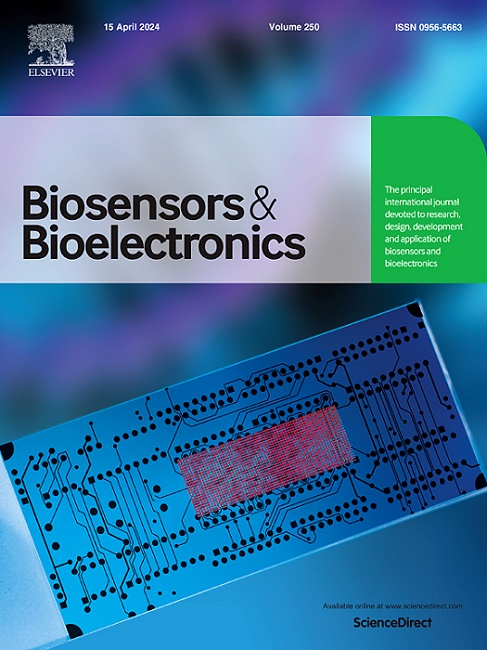用于现场检测针灸治疗时组织间液中外泌体的 GO-aptamer 水凝胶微针传感器
IF 10.5
1区 生物学
Q1 BIOPHYSICS
引用次数: 0
摘要
针灸治疗在治疗或改善慢性疾病方面取得了良好的临床效果。外泌体在针灸的信息传递和网络调节中起着至关重要的作用,其内容可能对针灸的效果至关重要。然而,在针灸治疗研究中,仍然迫切需要一种高度敏感的方法来检测外泌体,特别是快速和精确的分析。本文设计了一种氧化石墨烯适体水凝胶微针传感器(GOA-HMS),用于针灸治疗的外泌体护理点测试(POCT)。该传感器由氨基苯基硼酸(APBA)修饰的海藻酸钠与硫酸软骨素和氧化石墨烯纳米片交联制成,其中氧化石墨烯作为猝灭剂,与荧光基团修饰的核酸适体偶联。在没有目标外体的情况下,适体与氧化石墨烯紧密结合,猝灭荧光团标记。在外泌体存在的情况下,适体与靶标结合,引起构象变化,改变荧光基团与氧化石墨烯的距离,导致荧光恢复和荧光信号的产生。该传感器线性范围为105-109个颗粒/mL,检测限为1个颗粒/mL,对107个颗粒/mL外泌体进行7次重复检测,精密度为4.3% (RSD),证明了临床即时诊断和高通量的可行性。同时,通过典型的酶联免疫吸附试验(ELISA)进一步验证了该GOA-HMS测定的准确性。GOA-HMS成功应用于针灸治疗中的外泌体检测,为实时监测患者反应和研究针灸机制提供了一种无创的原位工具。本文章由计算机程序翻译,如有差异,请以英文原文为准。
GO-aptamer hydrogel microneedle sensors for the on-site detection of exosomes in interstitial fluid on acupuncture treatment
Acupuncture treatment had achieved good clinical effects on treat or ameliorate chronic diseases. Exosomes are crucial for transmitting information and network regulation in acupuncture, and their content could be essential for acupuncture's effects. However, there remains a critical need for a highly sensitive approach to detect exosomes in acupuncture therapy studies, particularly for rapid and precise analysis. Herein, a graphene oxide-aptamer hydrogel microneedle sensor (GOA-HMS) was designed for exosome point of care testing (POCT) on acupuncture treatment. The sensor was fabricated by cross-linking of aminophenylboronic acid (APBA)-modified sodium alginate with chondroitin sulfate and GO nanosheets conjugated with a fluorophore-modified nucleic acid aptamer, in which GO served as a quencher. In the absence of the target exosome, the aptamer binds tightly into the GO, quenching the fluorophore labels. In the presence of exosome, the aptamer binds to the targets, causing a conformational change which alters the distance the fluorescent moieties from the GO, leading to fluorescence recovery and the generation of fluorescent signals. This sensor showed a linear range of 105-109 particles/mL and has a detection limit of 1 particles/mL with an excellent precision of 4.3 % (RSD) for seven repeated detections of 107 particles/mL exosome, demonstrating the feasibility of both point-of-care clinical diagnostics and high throughput. Meanwhile, typical enzyme-linked immunosorbent assay (ELISA) assay further verified the measurement accuracy by this GOA-HMS. The GOA-HMS was successfully applied to exosome detection in acupuncture treatment, providing a non-invasive, in situ tool for monitoring patient responses in real-time and investigating acupuncture mechanisms.
求助全文
通过发布文献求助,成功后即可免费获取论文全文。
去求助
来源期刊

Biosensors and Bioelectronics
工程技术-电化学
CiteScore
20.80
自引率
7.10%
发文量
1006
审稿时长
29 days
期刊介绍:
Biosensors & Bioelectronics, along with its open access companion journal Biosensors & Bioelectronics: X, is the leading international publication in the field of biosensors and bioelectronics. It covers research, design, development, and application of biosensors, which are analytical devices incorporating biological materials with physicochemical transducers. These devices, including sensors, DNA chips, electronic noses, and lab-on-a-chip, produce digital signals proportional to specific analytes. Examples include immunosensors and enzyme-based biosensors, applied in various fields such as medicine, environmental monitoring, and food industry. The journal also focuses on molecular and supramolecular structures for enhancing device performance.
 求助内容:
求助内容: 应助结果提醒方式:
应助结果提醒方式:


